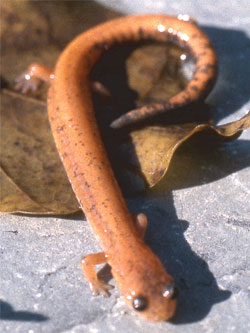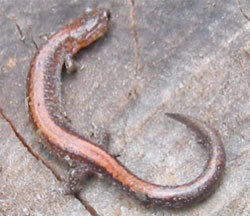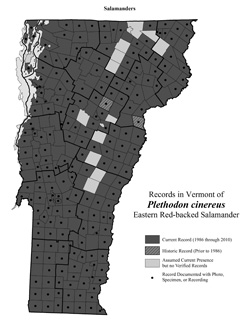Plethodon cinereus
Eastern Red-backed Salamander
Identification
The Easten Red-backed Salamander is one of the three slender and delicate salamanders in Vermont along with the Four-toed and the Northern Two-lined. Adults range from 3½ - 5 inches in length. It usually has a red-brown back with darker sides. Their belly is a salt and pepper mix of white and gray that looks like granite. Occasionally salamanders missing the red color (lead phase) or missing the dark sides (red phase) can be found.
Red-backed salamanders lay their eggs in grape-like clusters of 3 - 17, out of the sun, generally under or in moist logs.
Range/Habitat
The Red-backed can usually be found in damp locations under leaf litter or in the coarse woody debris of mature deciduous or mixed hardwood forests. They are not normally found where the soil is saturated or acidic. Red-backs are entirely terrestrial and overwinter underground.
The Eastern Red-backed is found statewide.
Status
This species has a state natural heritage rank of S5. Please report sightings of this species in Vermont if you have not reported them within the last five years from a given location. Any natural history observations (feeding, migrations, road crossing areas, early or late season appearance, abnormalities, etc.) are appreciated. Photographs are always helpful, particularly if your report is the first report of this species from a town.
More Info
- Plethodon cinereus at Animal Diversity website
- Plethodon cinereus at Amphibiaweb
- Plethodon cinereus at the CARCNET website
- Plethodon cinereus at the Yale Peabody Museum of Natural History website
Species summary written by Kaile Burgess.
Plethodon cinereus: red phase

Photo by L. Brook.


